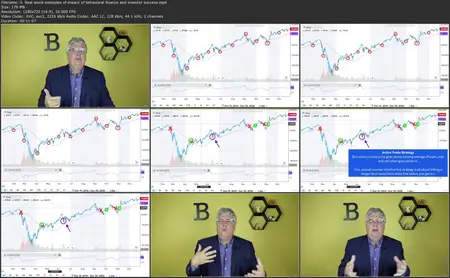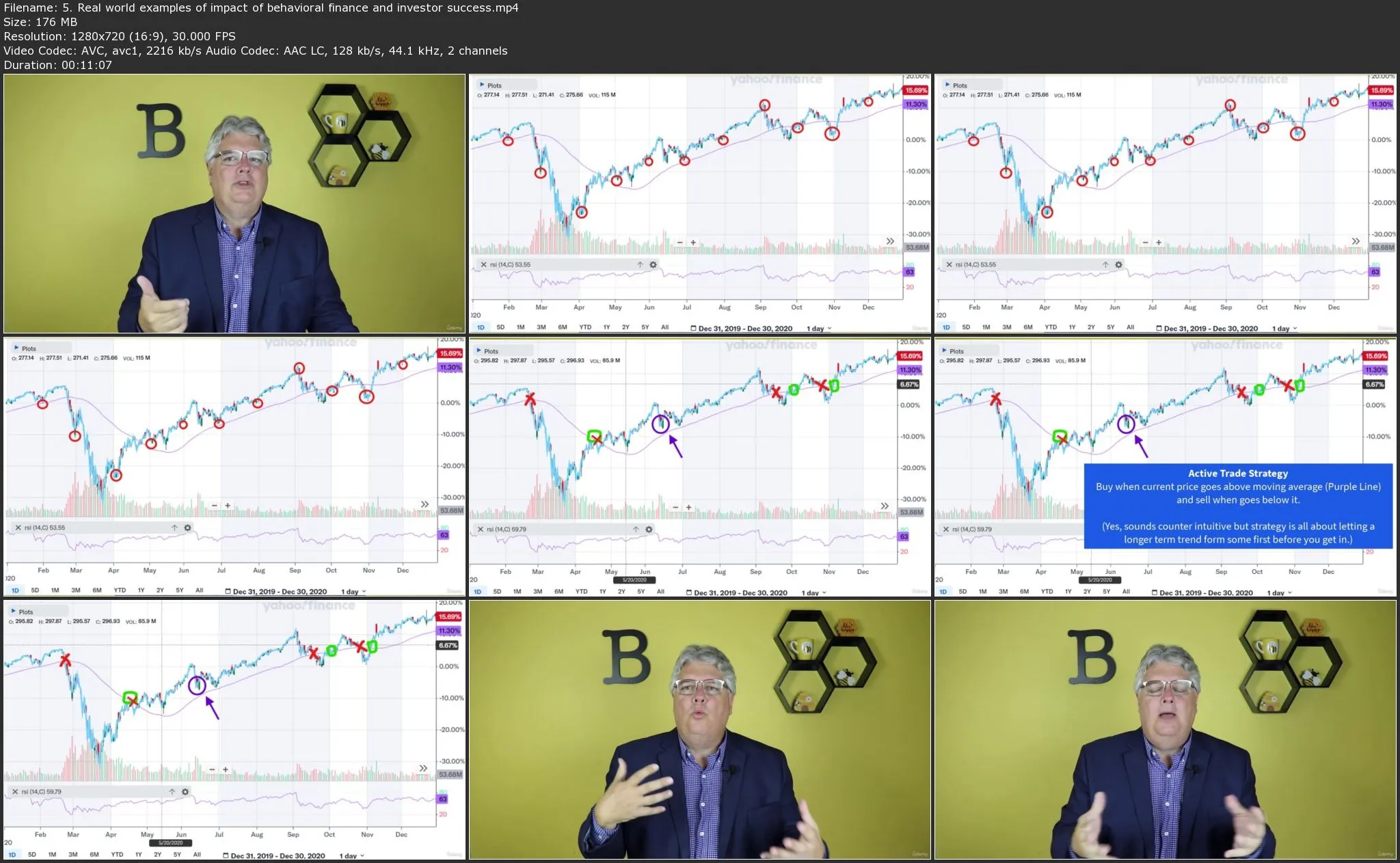Behavioral Finance: Making Smarter Investment Decisions
.MP4, AVC, 1280x720, 30 fps | English, AAC, 2 Ch | 2h 3m | 2.62 GB
Instructor: Steve Ballinger, MBA
.MP4, AVC, 1280x720, 30 fps | English, AAC, 2 Ch | 2h 3m | 2.62 GB
Instructor: Steve Ballinger, MBA
Real-World Aspects of Behavioral Finance Principles: Harnessing Emotions to Avoid Poor Decision Investment Decisions
What you'll learn
- Practical Insights: Gain real-world insights into how behavioral finance principles apply to everyday investment decisions.
- Grasp the key principles and concepts of including cognitive biases, emotional influence, and social factors that impact financial decision-making.
- Identify & Overcome Common Cognitive Biases, such as overconfidence, anchoring, confirmation bias, and mental accounting, and learn strategies to mitigate them.
- Understand how emotions like fear, greed, & regret influence investor behavior & market dynamics, and develop techniques to manage these emotions effectively.
- Enhance long-term investment success by integrating behavioral finance principles into portfolio management, emphasizing disciplined & rational decision-making.
Requirements
There are no prerequisites other than a desire to learn how our our behaviors and psychology can impact ur investing resutls.
Description
Unlock the Power of Behavioral Finance to Avoid Costly Mistakes and Enhance Your Investment Strategies!
Are you ready to transform your investment approach by understanding the psychological factors that influence financial decisions? Many think that investing is all about facts and numbers which is true to an extent but as human beings we have powerful emotions and psychological viewpoints plus diverse past experiences that tremendously impact our investing decsion making and ultimately our success. Enroll in this course and gain the insights you need to navigate the complexities of financial markets with confidence.
Investing is not as black and white and logical as it may seem. Our behaviors and psychology play an enormous role. By learning about behavioral finance, you will be better equipped to harness your emotions, recognize biases, and make smarter investment decisions that contribute to your financial goals.
Maybe This Has Happened To You
Selling in a Market Panic:
You see the market falling rapidly and decide to sell your investments because everyone else is doing it. This is a classic example of herding behavior and can lead to selling at a loss.
Holding onto Losing Investments:
You have a stock that has been declining in value, but you refuse to sell it, hoping it will recover to avoid feeling the regret of a loss. This is an example of regret aversion and loss aversion.
Overtrading Due to Overconfidence:
You believe you have superior trading skills and can predict market movements accurately, leading you to trade frequently. Overconfidence bias often results in higher transaction costs and poorer overall returns.
Ignoring Negative Information:
You invest in a company you believe in and selectively ignore negative news about it, focusing only on information that supports your decision. This is confirmation bias in action.
Spending Windfall Gains Recklessly:
You receive a bonus or inheritance and spend it on luxuries rather than saving or investing it wisely. This behavior is influenced by mental accounting, where money is treated differently based on its source.
Making Decisions Based on Recent Events:
After reading news about a recent market crash, you become overly pessimistic and avoid investing, despite positive long-term prospects. This is availability bias affecting your decision-making.
Overreacting to Short-Term Market Movements:
You make investment decisions based on short-term market fluctuations rather than long-term fundamentals, leading to buying high and selling low. This often results from framing effects and emotional reactions.
Refusing to Sell an Owned Asset:
You hold onto a stock or property you own because you believe it's worth more than the market price, despite evidence to the contrary. This is known as the endowment effect.
Following Hot Stock Tips:
You invest in a stock because you heard a tip from a friend or saw it trending online, without conducting your own research. This is an example of herding behavior and can lead to poor investment choices.
Avoiding Necessary Risk:
You avoid investing in stocks entirely because you're afraid of losing money, even though it's necessary for long-term growth in your retirement portfolio. This demonstrates loss aversion and regret aversion.
By recognizing these common pitfalls, you can learn to identify and mitigate the biases that lead to poor decision-making in investing. Join our course to gain deeper insights into these behaviors and develop strategies to make smarter, more rational investment decisions.
Some Of What You Will Learn
Introduction to Behavioral Finance:
- Discover the fundamentals of behavioral finance and how it differs from traditional finance.
- Learn about the key psychological concepts that impact financial decision-making.
Prospect Theory and Loss Aversion:
- Understand prospect theory and how it explains decision-making under risk and uncertainty.
- Learn about loss aversion and why losses loom larger than gains in investors' minds.
- Apply these concepts to real-world scenarios to better manage investment risks.
Mental Accounting:
- Explore the concept of mental accounting and how people mentally separate their money into different 'accounts.'
- Understand how this can lead to irrational financial behavior, such as spending windfalls differently from regular income.
- Learn strategies to manage your finances more effectively by overcoming mental accounting biases.
Anchoring Bias and Its Effects:
- Understand anchoring bias and how initial information or 'anchors' can skew our perceptions and decisions.
- See how anchoring affects stock valuations, real estate prices, and other financial decisions.
- Learn techniques to recognize and mitigate the effects of anchoring bias in your investment decisions.
Confirmation Bias and Overconfidence:
- Discover how confirmation bias leads us to seek out information that confirms our preconceptions while ignoring contradictory evidence.
- Understand the impact of overconfidence on trading behavior and risk management.
- Learn practical methods to counter these biases and make more balanced investment decisions.
Herding Behavior:
- Explore the phenomenon of herding behavior, where individuals follow the actions of a larger group.
- Understand the implications of herding for financial markets, including the formation of bubbles and crashes.
- Learn how to recognize herding behavior in the market and develop strategies to avoid its pitfalls.
Regret Aversion and Availability Bias:
- Understand regret aversion and how the fear of making decisions that could lead to regret influences investment choices.
- Learn about availability bias, where readily available information overly influences decision-making.
- See real-world examples of how these biases can lead to poor investment decisions and learn strategies to avoid them.
Framing Effects and Endowment Effect:
- Discover how the framing of information can significantly impact decision-making and risk perception.
- Understand the endowment effect, where ownership increases the perceived value of an asset.
- Learn to identify and counteract these biases to make more objective investment decisions.
The next step is to click the enroll button and let's get started learning about behavioral finance to help you become a better investor!
Thanks.
Steve Ballinger
What is Behavioral Finance and Why is it Important to Investors?
Understanding Behavioral Finance
Behavioral finance is a field of study that combines insights from psychology, sociology, and traditional finance to understand how human behavior affects financial decision-making. Unlike traditional finance, which assumes that investors are rational and markets are efficient, behavioral finance acknowledges that investors are often influenced by cognitive biases, emotions, and social factors.
Key concepts in behavioral finance include:
- Cognitive Biases: Systematic patterns of deviation from rationality in judgment, such as overconfidence, anchoring, and confirmation bias.
- Emotional Influences: The impact of emotions like fear, greed, and regret on investment decisions.
- Social Factors: The effects of social influences and herd behavior on market trends and individual investor actions.
Why Behavioral Finance is Important to Investors
Understanding behavioral finance is crucial for investors for several reasons:
1. Improved Decision-Making:
By recognizing and understanding their own biases, investors can make more informed and rational decisions. For instance, being aware of overconfidence can help investors avoid excessive trading and unnecessary risks.
2. Risk Management:
Behavioral finance helps investors develop strategies to manage emotional responses to market fluctuations. This can prevent panic selling during market downturns or excessive optimism during bull markets.
3. Enhanced Investment Strategies:
Incorporating behavioral insights into investment strategies can lead to better outcomes. For example, recognizing herd behavior can help investors avoid buying into market bubbles.
4. Long-Term Success:
Behavioral finance promotes long-term thinking by helping investors focus on fundamentals rather than short-term market movements. This can lead to more stable and sustainable investment performance.
5. Market Efficiency:
Understanding how psychological factors influence market behavior can provide insights into market inefficiencies. This knowledge can be used to identify investment opportunities that others might overlook.
6. Real-World Examples:
Historical market events, such as the Dot-com bubble and the 2008 financial crisis, highlight the impact of behavioral biases on financial markets. By studying these events, investors can learn valuable lessons about managing their own behavior.
7. Financial Well-Being:
Behavioral finance can improve overall financial well-being by encouraging better saving, spending, and investing habits. Understanding mental accounting, for example, can help individuals manage their finances more effectively.
Conclusion
Behavioral finance provides a more comprehensive understanding of how markets operate and how investors make decisions. By integrating these insights, investors can enhance their decision-making processes, manage risks more effectively, and achieve better long-term financial outcomes. Whether you are a novice investor or a seasoned professional, understanding behavioral finance is essential for navigating the complexities of the financial markets and avoiding common pitfalls that can undermine your investment success.
Who this course is for:
- Individual Investors: Enhance your investment strategies by understanding the psychological factors that influence your decisions.
- Financial Professionals: Gain a deeper understanding of behavioral finance to better serve your clients and improve portfolio management.





